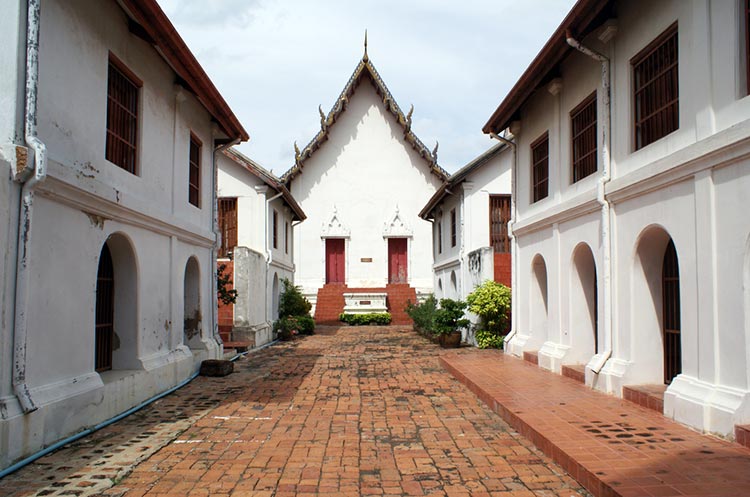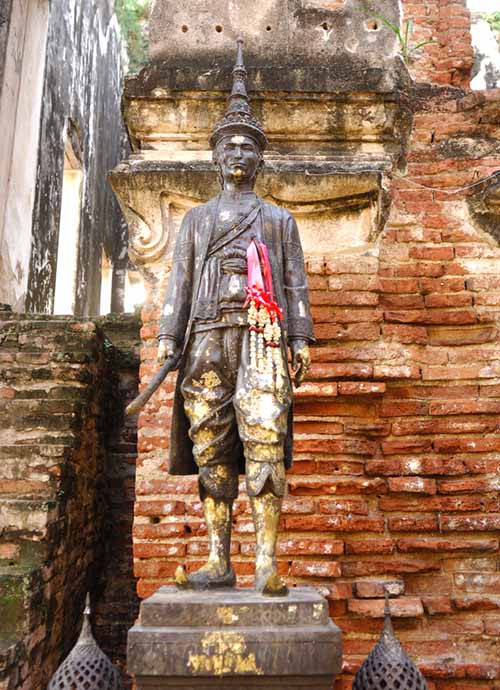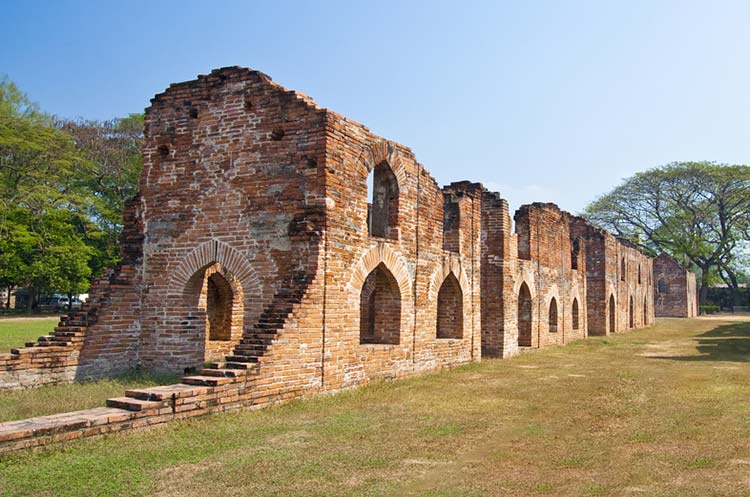
King Narai’s Palace
17th Century palace in Lopburi town
King Narai’s Palace, officially named Phra Narai Ratchaniwet is the former palace of Ayutthaya King Narai. The ruins of the palace, locally known as Wang Narai are located in the old center of Lopburi town.
King Narai the Great, King of Ayutthaya during the second half of the 17th century made Lopburi the second capital of the Ayutthaya Kingdom. He ordered a new palace built near the Lopburi river where he stayed most of the year. The palace was designed by French architects in a mix of Thai and European architectural styles. Construction started in 1665 and was completed 12 years later in 1677.
After King Narai’s death in 1688 the palace was abandoned. Nearly two centuries later King Mongkut ordered restoration of the palace and the construction of several new buildings. Nowadays, the palace buildings are in use as exhibition halls for the Lopburi museum.
Buildings of the Palace
The 17 acres palace grounds are enclosed by brick walls covered with plaster. In the walls are thousands of niches shaped as lotus flowers that contained oil lamps that illuminated the palace at night. Eleven gates provide access to the grounds.
King Narai’s Palace consists of buildings from different eras. The oldest date back to the reign of King Narai, the others date from the reign of King Mongkut (Rama IV) around 1860. The palace grounds consists of an inner courtyard, central courtyard and outer courtyard, separated from each other by high walls.
The outer courtyard
The outer courtyard contains several 17th century buildings. In the center of the Royal garden, partially surrounded by a canal with fountains is the reception hall for foreign visitors, also known as the Banquet Hall. King Narai used the French architectural style hall to hold banquets for the French envoys. In front of it was a theatre where performances for the foreign guests were held.
The Phra Chao Hao building is a large Thai style brick building dating back to the 17th century. It contained an image of the Buddha and was probably used by King Narai for worshipping. The building is in fairly good state of preservation. Its high walls are still standing, the arches over the doors and windows are intricately decorated with fine patters.
Twelve storage houses or treasury buildings called Phra Khlang Supharat were built in the 17th century. The buildings were used to store Royal property such as swords, clothing and elephant tusks as well as goods sold to foreign traders. Only the base remains of the Royal elephant stables and the small houses for the mahouts.

The central courtyard
The most significant building of the central courtyard is the Dusit Sawan Thanya Maha Prasat Throne Hall. The hall is a mix of Thai and French architectural styles; the front part is in French style, the rear in Thai style. Originally built as an audience hall, King Narai used the building to receive foreign diplomats.
According to the accounts of French visitors, the hall reflected the splendor of King Narai’s court, its interior filled with fine crystal and imported French mirrors. Inside the hall is a statue honouring the palace’s builder, King Narai the Great. Next to it is a low relief sculpture depicting Monsieur Chevalier de Chaumont, the ambassador of Louis XIV, presenting a letter to King Narai at the Grand Palace in Ayutthaya in 1685.
The inner courtyard
The inner courtyard contains buildings from both the 17th and 19th centuries. In a garden with a large pond at each of its four corners is the Suttha Sawan Throne Hall. The European architectural style building was King Narai’s private residence; the King passed away here in 1688.
The Phiman Mongkut Group of Throne Halls was built in 1862 by King Mongkut in European style. The cluster consists of several buildings including a weapons room, a Royal Hall, a reading room and a private residence of King Mongkut. The Phiman Mongkut buildings are currently in use by the Lopburi Museum.
The Chantara Phisan Throne Hall was built in 1665 on the foundations of a 14th century palace. The Thai style building with a multi tiered roof resembles a viharn or assembly hall of a Buddhist temple. The hall served as the Royal residence for King Narai. Later when the Suttha Sawan Throne Hall had been completed and the King moved there, the Chantara Phisan Hall was turned into a building where the King had meetings with his advisors. The hall is currently in use as exhibition room of the Lopburi Museum.
The Phra Prathiab buildings were built by King Mongkut. The cluster of buildings served as residences for the Queen and consorts of King Mongkut. Today the buildings are exhibition rooms of the Lopburi Museum.

Lopburi Museum
Several buildings of King Narai’s Palace are in use as exhibition rooms of the Lopburi Museum. The museum, officially named Somdet Phra Narai National Museum exhibits artifacts from prehistoric times until present.
The Phiman Mongkut pavilion exhibits art from several eras of Thai history, including Dvaravati, Khmer, Lopburi and Ayutthaya. On display are prehistoric finds from Lopburi and other provinces, including skeletons, bronze tools and pottery. Artifacts of more recent eras include Buddha images from various periods including Lanna, Hariphunchai, Ayutthaya and Khmer, votive tablets, inscriptions in ancient Sanskrit and Pali languages, Khmer lintels and personal items that belonged to King Mongkut (Rama IV).
The Chantara Phisan Throne Hall exhibits artifacts that belonged to King Narai such as his costumes and paintings. A display shows life in the Royal Palace during the reign of King Narai. The Phra Prathiab buildings exhibit traditional Lopburi handicrafts, ceramics and porcelain items.
The museum opens Wednesday thru Sunday from 9 am until 4 pm, except on Thai National Holidays.
How to get to Phra Narai Ratchaniwet
The palace is located next to the Wat Phra Sri Rattana Mahathat in the old center of Lopburi town, a few hundred meters West of the main train station. Its main entrance is on Thanon Sorasak.
The palace is within walking distance of Lopburi train station (about 500 meters). From anywhere in the old town, charter a samlor (bicycle taxi) for about 40 Thai Baht.
Opening hours
The Phra Narai Ratchaniwet opens Wednesday thru Sunday from 8:30 am until 4 pm.
The grounds remain open until 5:30 pm.
Closed on Thai National Holidays.
Entrance fee
Admission charged at the ticket booth is (Thai Baht):
- Prang Sam Yot Khmer temple
- Wat Phra Sri Rattana Mahathat
- King Narai’s Palace
- Wichayen House
- Monkey Festival
- Lopburi Sunflower Fields